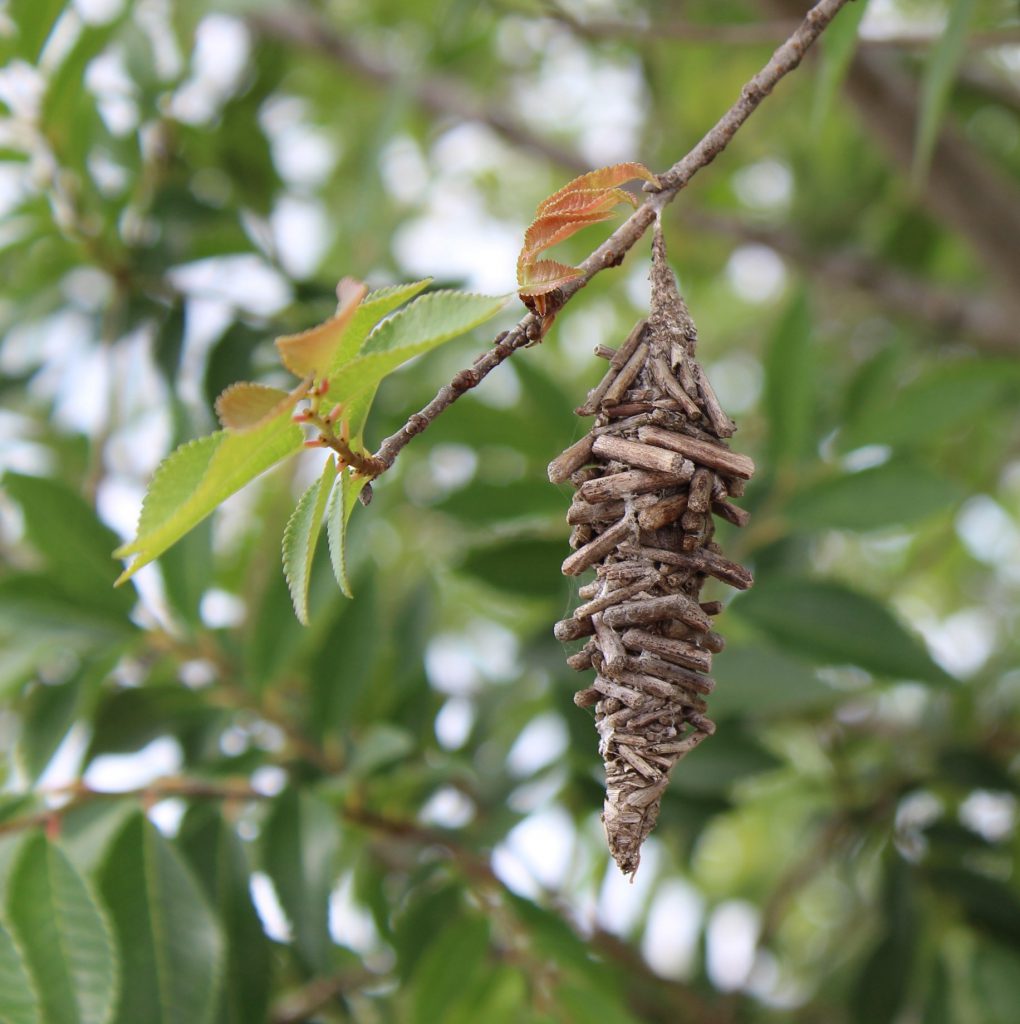
As we explore the landscaping at our new facility at Centennial Park in Port Charlotte, we continue to find new things. A staff member discovered an infestation of bagworms nestled amongst some flax lilies and ‘Drake’ Chinese elms. Camouflaged in its leaf-litter covered bag, the bagworm can be very damaging to certain local ornamental plants.
Our particular outbreak of bagworms seems to have been an old infestation. This bagworm is known by many names including the eastern bagworm, the common bagworm, the common basket worm or the evergreen bagworm. The adult is a moth which you may never see or notice. The female moth is wingless and stays inside her “bag” and pupal case unseen. Her wings, legs, eyes, mouth and antennae are small or missing. In fact, she looks more like a caterpillar than an adult moth and her only role is to mate and lay eggs within her lifespan of a couple of weeks. The short-lived adult male moth has wings and finds the female via her release of certain chemicals called pheromones. He follows the pheromone scent trail to the female and then mates. The female then lays up to one-thousand eggs in her bag which hatch and disperse parachute-style across the landscape on silken threads. Some even remain on the food plant host of the mother bagworm. The bagworm caterpillars favor plants such as Indian hawthorn, juniper, arborvitae, live oak, willows, maples, elms, pines, viburnum, and Ligustrum. As it grows, the caterpillar builds a tough silken bag and covers it with twigs and bits of leaf remains from its meal – great camouflage and protection! Only the head and legs come out of the bag as it feeds on plant materials moving about protected in this silk and plant debris coating. After four months of suitable summer temperatures, the caterpillar will be about once inch in size within the larger, up to two-inch long bag. Once mature, the larva anchors itself in place with silk and pupates for up to ten days before emerging as an adult.
This type of bagworm is not to be confused with the smaller one’s found on lanais.
Locally, I have seen these bagworms doing some damage on Indian Hawthorn and junipers in landscapes. In one case further north of Charlotte County, I saw numerous Indian Hawthorns essentially defoliated by bagworms. While these large larvae can do a fair amount of leaf damage and an infestation may be heavy, it tends to be localized. Perhaps the best and easiest way to suppress this pest is to monitor frequently and hand-pick the bags as they are discovered. While it is difficult to get insecticides in through the protective bags, a biological insecticide such as Bt or Bacillus thuringiensis var. kurstaki, can be used with success on the smaller caterpillars when applied as per label instructions. Parasitic wasps also abound in nature and commonly attack bagworms.
Bagworms can do some damage, but regular monitoring pays off and this pest is generally easy to get under control. For more information on landscape insects and their suppression, or to ask a question, please visit https://www.facebook.com/CharlotteMGLifeline/ . Ralph E. Mitchell is the Director/Horticulture Agent for the UF/IFAS Charlotte County Extension Service. He can be reached at 941-764-4344 or ralph.mitchell@charlottecountyfl.gov.
Resource:
Moffis, B. L. & Arthurs, S. P. (2016) Bagworm, Thyridopteryx ephemeraeformis Haworth (Insecta: Lepidoptera: Psychidae). The University of Florida Extension Service, IFAS.
 0
0
